A year-long case study running an options-based portfolio was conducted to demonstrate the effectiveness of this strategy against the traditional stock-picking approach. Options are a great way to manage and mitigate risk while circumventing market swings. Selling options allows you to collect premium income in a high-probability manner while generating consistent income for steady portfolio appreciation regardless of market conditions. Of course, this is all done without predicting which way the market will move since options are a bet on where stocks won’t go, not where they will go.
Primarily sticking with dividend-paying large-cap stocks across a diversity of tickers that are liquid in the options market is a great way to generate superior returns with less volatility over the long term. Over the past 12 months, 298 trades have been made with a win rate of 86% and premium capture of 57% across 69 different tickers. Moreover, when stacked up against the S&P 500, an options strategy generated a return of 6.9% compared to the S&P 500 index, which returned 2.2% over the same period. These returns demonstrate the resilience of this high probability options trading in both bear and bull markets.
This outperformance and high win rate was achieved by following a set of options-based fundamentals. Specifically, position-sizing, sector allocation, maximizing the number of trade occurrences, and risk-defined strategies are some notable areas that traders need to heed for long-term successful options trading.
Essential Options Trading Fundamentals
To effectively and successfully run an options-based portfolio over the long term, the following options trading fundamentals must be exercised in each and every trade. Violating any of these fundamentals will jeopardize this strategy and possibly negate the effectiveness of this approach on the whole.
- 1) Be an option seller to collect premium income while taking advantage of time decay
- 2) Set the probability of success (delta) in your favor (70%, 85%, etc.) to ensure a statistical edge
- 3) Manage winning trades by closing the trade and realizing profits early in the option lifecycle
- 4) Sell options in high IV Rank environments to extract rich premiums
- 5) Sell options on tickers that are liquid in the options market
- 6) Maximize the number of trades to allow the expected probabilities to play out
- 7) Appropriate position sizing/portfolio allocation to manage risk exposure
- 8) Sell options across tickers with ample sector diversity
Maximizing Number of Trade Occurrences
Maximizing the number of trades is essential for any options-based strategy. Placing only 10 trades or 50 trades over a given time period is simply inadequate for an options-based approach. Instead, trading through all market conditions at a specific probability of success level, given enough trades and time, the probabilities will reach their expected outcomes. This maximizes the number of shots on goal. Over a long enough time period, these data will be smoothed out over the various market conditions to reach your expected probability of success. To achieve the expected probability level, hundreds of trades need to be placed and closed before the probabilities really begin to play out. As these trade data grow in size, plotting all of your trades over time, you’ll see the numbers align more and more with your expected probabilities. Taken together, trade as often as you can at your desired probability of success to achieve the win rate of interest (Figure 1).

Figure 1 – Dot plot summarizing ~300 trades over the previous 12-month period highlighting the importance of maximizing trades and trading through all market conditions
Position Sizing and Sector Allocation
Position sizing is critical, and being over-leveraged and assigned a losing trade can have a disproportionate negative impact on your portfolio and possibly negate all your successes. Restricting position sizing to ~5% or less of your overall portfolio will help to manage risk and contain unrealized losses. In addition, if and when positions move against you, maintaining a small position size will keep your risk profile in check.
Trading across all sectors will ensure portfolio diversity and effective risk management as a result of the breath of uncorrelated stocks. In addition, selling options across a wide array of tickers and sectors will safeguard your portfolio from any given sector downturn (i.e., oil-related stocks and retail weakness).
Risk Defined Strategy
Spreads can be deployed to risk-define your trades. For example, when selling a put option, you agree to buy shares at an agreed-upon price by an agreed-upon date in exchange for premium income. Likewise, you agree to sell shares at an agreed-upon price by an agreed-upon date in exchange for premium income when selling a call option.
An option spread is where you sell an option and also buy a further out-of-the-money option for protection. For put spreads, selling the option is where you agree to buy the shares, and buying the option is where you have the ability to sell the shares. For example, if you sell a put option at a strike price of $50 in exchange for $100 in premium, you can use some of that credit to buy the $45 strike put option for $40 to net $60 on the trade ($100 - $40). In this manner, you agree to buy shares at $50 or less. However, if the shares were to dive, you also have the right to sell shares at $45. This will cap your losses at $440 if the stock tanks since you would be assigned at $50 and exercise your right to sell shares at $45 per share less the net premium received of $60. The $5 per share loss is the max loss one can incur, and factoring in the $60 of premium income, the net loss is capped at $440.
The Takeaway
Options trading allows one to profit without predicting which way the stock will move. Options trading isn’t about whether or not the stock will move up or down; it’s about the probability of the stock not moving up or down more than a specified amount. Options allow your portfolio to generate smooth and consistent income month after month for steady portfolio appreciation. Running an option-based portfolio offers a superior risk profile relative to a stock-based portfolio while providing a statistical edge to optimize favorable trade outcomes. Options trading is a long-term game that requires discipline, patience, time, maximizing the number of trade occurrences, and continuing to trade through all market conditions. Put simply; an options-based approach provides a margin of safety with a decreased risk profile while providing high-probability win rates. The basic building blocks of running an options-based portfolio includes appropriate position sizing, diversity of tickers (stocks and ETFs), diverse sector exposure, trading through all market environments, maximizing the number of trades, managing risk, options liquidity, and taking profits early.
Over the previous 12 months, the options-based approach outperformed the index by a wide margin (Figures 2 and 3). Over the previous 12 months, my win rate percentage was 86% (255/298). Over the same period, the options-based portfolio generated a 6.9% return relative to 2.2% for the S&P 500, outperforming the index by a wide margin (Figures 2 and 3).

Figure 2 – Options based portfolio return (6.9%) in comparison to the S&P 500 return (2.2%) over the past 12 months through both bear and bull market conditions. S&P 500 closed at $2,913.98 on September 30th 2018 and closed at $2,976.74 on September 30th 2019

Figure 3 – Comprehensive options metrics over the previous 12 months
Conclusion
Maximizing the number of trade occurrences, position-sizing, diverse sector exposure, trading stocks, and ETFs and managing winning trades is essential for an options-based portfolio to succeed over the long term. In addition, options trading allows one to profit without predicting which way the stock will move, allowing your portfolio to generate smooth and consistent income month after month since options are a bet on where stocks won’t go, not where they will go.
Selling options with a favorable risk profile and a high probability of success is the key. Options provide long-term durable high-probability win rates to generate consistent income while mitigating drastic market moves. For example, I’ve demonstrated an 86% options win rate over the previous 12 months through both bull and bear markets while outperforming the S&P 500 over the same period by a wide margin producing a 6.9% return against a 2.2% for the S&P 500 with a lower risk profile. Taken together, options trading is a long game that requires discipline, patience, time, maximizing the number of trade occurrences, and continuing to trade through all market conditions with the probability of success in your favor.
Thanks for reading,
The INO.com Team
Disclosure: The author holds shares in AAPL, AMZN, DIA, GOOGL, JPM, MSFT, QQQ, SPY and USO. The author has no business relationship with any companies mentioned in this article. This article is not intended to be a recommendation to buy or sell any stock or ETF mentioned.
